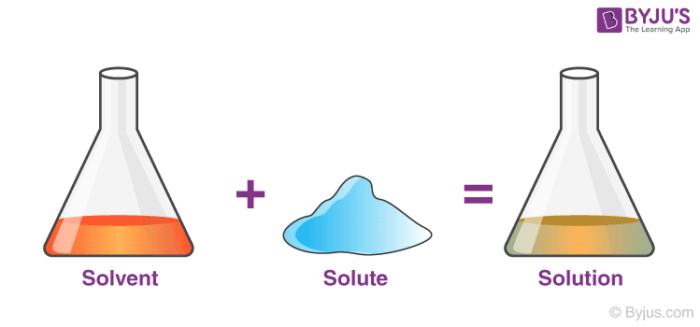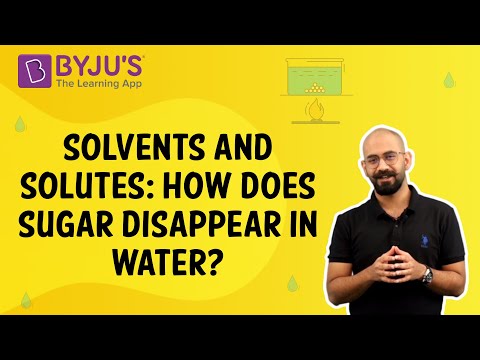What is Solute?
A substance that is dissolved in a solution is called a solute.
In fluid solutions, the amount of solvent present is greater than the amount of solute. One best example of solute in our day to day activity is salt and water. Salt dissolves in water and therefore, salt is the solute.
Recommended Videos

A homogeneous mixture composed of two or more substances, in which a mixture, a solute is a substance dissolved in another substance known as a solvent. The concentration of a solute in a solution is a measure of how much of that solute is dissolved in the solvent, with regard to how much solvent is present like salt.

Characteristics of Solute
- A solution is a homogeneous mixture of two or more substances.
- The particles of solute in a solution cannot be seen by the naked eye.
- A solution does not allow beams of light to scatter.
- A solution is stable.
- The solute from a solution cannot be separated by filtration (or mechanically).
- It is composed of only one phase.
To Know About Solvents And Solutes, Watch The Below Video:

Types of Solute
Homogeneous means that the components of the mixture form a single phase. Heterogeneous means that the components of the mixture are of different phase.
The properties of the mixture including concentration, temperature, and density can be uniformly distributed through the volume but only in the absence of diffusion phenomena or after their completion. The major types of solute are:
- Gaseous
- Liquid
- Solid
-
Gaseous:
If a solvent is a gas, then only gases are dissolved under a given set of conditions. An example of a gaseous solution is air such as oxygen and other gases dissolved in nitrogen.
-
Liquid:
If the solvent is a liquid, then almost, liquids, and solids can be dissolved. Here are some examples:
- Gas in liquid
- Oxygen in water
- Carbon dioxide in water
- Liquid in liquid
- The mixing of two or more substances of the same chemistry but different concentrations to form a constant.
- Alcoholic beverages are basically solutions of ethanol in water.
- Solid in liquid:
- Sucrose (sugar) in water
- Sodium chloride (NaCl) (salt) in water.
-
Solid:
If the solvent is solid, then gases, liquids and solids can be dissolved.
- Gas in solids
- Hydrogen dissolves rather well in metals, especially in palladium;
- Liquid in solid
- Mercury in gold, forming an amalgam
- Water in solid salt or sugar, forming moist solids
- Hexane in paraffin wax
- Solid in solid
- Steel, basically a solution of carbon atoms in a crystalline matrix of iron atoms.
- Alloys like bronze and many others.
- Polymers containing plasticizers.
Solute Examples
The solute examples are listed below with the corresponding solution.
| Solutions | Corresponding solute in the solution |
| Brass alloy | Zinc in copper |
| Amalgam | Mercury in silver |
| Antifreeze in radiator | Ethylene glycol in water |
| Carbonated beverages | CO2 in water |
| Air in atmosphere | Many gases in nitrogen |
| Bronze | Tin dissolved in copper |
| Sugar water | Sugar dissolved in water |
| Alcoholic drinks | Alcohol dissolved in water |
| Saltwater | Salt dissolved in water |
Saturated and Unsaturated solution
When a solution dissolves solute as much as possible at a particular temperature, is called a saturated solution. In simple terms, it can also be defined as, at a given temperature when no more solute can dissolve itself in the solution, it is a saturated solution. When the quantity of solute is not as same as the saturation level but less than that, it is known as an unsaturated solution.
Frequently Asked Questions
What is considered a solute?
A solute is typically a solid dissolved into a liquid. Salt is the solute that dissolves to form a saline solution in water, the solvent. On the other hand, water vapour is considered an air solute because nitrogen and oxygen are present in the gas at much higher levels of concentration.
What is a universal solute?
A common solvent is a product that most substances are dissolved. Water is considered the common solvent because more compounds are dissolved than any other solvent.
Is water a solute or a solution?
Two substances that are evenly mixed together are basically a simple solution. One is called the base, and the other is the solvent. A solution is a dissolving material (sugar). The solvent is the one that dissolves (water).
What is the difference between solute and solvent?
Difference Between solvent and Solute are the homogeneous mixture of two or more substances that can be known as a solution. So in a solution, the dissolving substance is water, whereas the liquid is the dissolving material.
What are the properties of solute?
Colligative properties are features a solution has that depend on the number of solute particles, not identity. In solutions, there is lower vapour pressure, higher boiling point, lower freezing point, and higher osmotic pressure.
Read more:


Muja class ,6 solution, solvent, solute
Click here to learn about the Solution